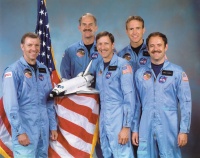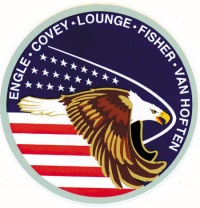STS-51I
From The Space Library
 | |
| Organization | NASA-Office of Space Flight (United States) |
|---|---|
| Mission type | Human Crew |
| Launch date | August 27, 1985 |
| Launch vehicle | Space Shuttle |
| Launch site | Cape Canaveral, United States |
| COSPAR ID | 1985-076A |
| Inclination | 28.45 degrees |
| Experiments | Here |
| Alternate Names | STS 20,15992 |
| Additional Information | Here |
| Data Collection | Here |
| Payload Mass Up | 19988 kg |
| Payload Mass Down | 6114.55 kg |
| Orbiter | Discovery |
| Lift Off Mass | 2,050,968.18 kg |
| Orbiter Weight at Liftoff | 119,231.36 kg |
| Orbiter Weight at Landing | 89,397.27 kg |
| Landed | Runway 23 dry lake bed at Edwards Air Force Base, Calif. |
| Orbits of Earth | 111 |
| Orbital Altitude | 190 nautical miles (218 statute miles) |
Contents |
[edit] Crew
- Commander: Joe H. Engle
- Pilot: Richard O. Covey
- Payload Commander:
- Mission Specialist 1: James van Hoften
- Mission Specialist 2: William F. Fisher
- Mission Specialist 3: John M. Lounge
- Mission Specialist 4:
- Mission Specialist 5:
- Payload Specialist 1:
- Payload Specialist 2:
ISS/Mir Crew Transport
[edit] Mission
STS 51-I was the sixth Discovery shuttle flight. On board were Joe Engle, Richard Covey, James Van Hoften, William Fisher, and John Lounge. Deployed during the mission were Aussat-1 (Australia), ASC 1 (American Satellite Corporation), and SYNCOM IV-4 (Hughes Corporation). A repair was made to SYNCOM IV-3 which was launched by STS 51-D in April 1985. SYNCOM IV-4 (also known as LEASAT-4) failed to function after reaching correct geosynchronous orbit. Fisher and van Hoften performed 11 hours, 27 minutes of space walk. Part of the time was spent retrieving, repairing and redeploying LEASAT-3, which was deployed on Mission 51-D. The Middeck Payload consisted of: Physical Vapor Transport Organic Solid Experiment (PVTOS). The mission duration was 170 hours 17 minutes 42 seconds.
[edit] EVA
Extravehicular Activity (EVA) conducted by James van Hoften and William Fisher during two spacewalks for a total of 11 hours, 46 minutes. EVA 1, 7 hours, 20 minutes; EVA 2, 4 hours, 26 minutes.
[edit] Payload
Deploy ASC (American Satellite Company)-1 with Payload Assist Module (PAM)-D; deploy AUSSAT (Australian communications satellite)-1 with PAM-D; deploy Syncom IV-4 communications satellite with its unique stage; retrieve Leasat-3 communications satellite, repair and deploy by extravehicular activity (EVA) astronauts; Physical Vapor Transport Organic Solids (PVTOS) experiment
[edit] Books about the Space Shuttle Program
Buy This Book Click here |
Buy This Book here |
Buy This Book Click here |
Buy This Book Click here |





